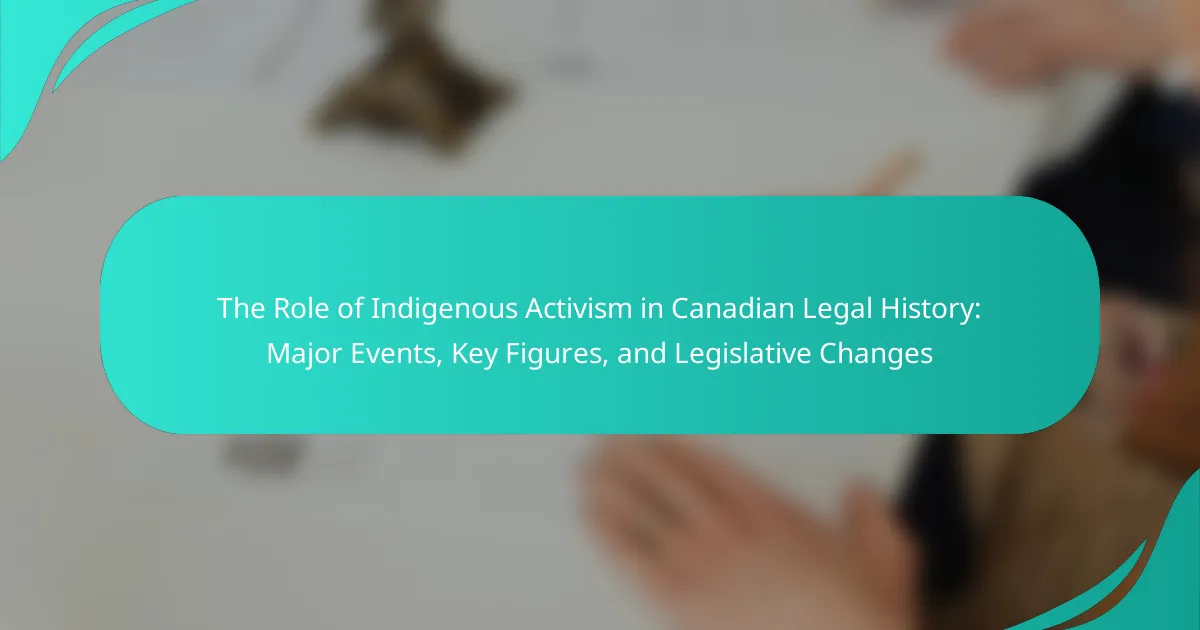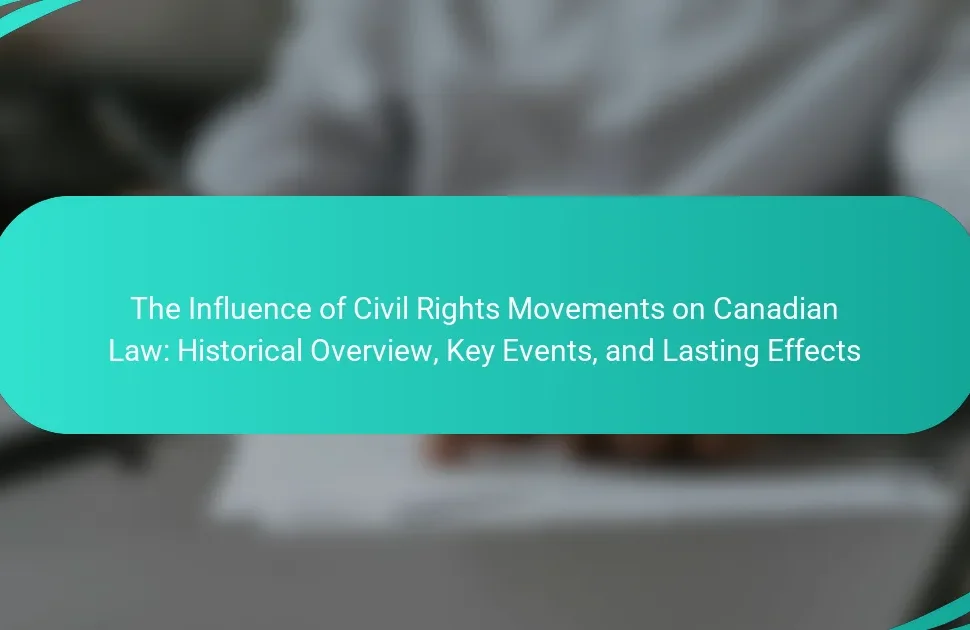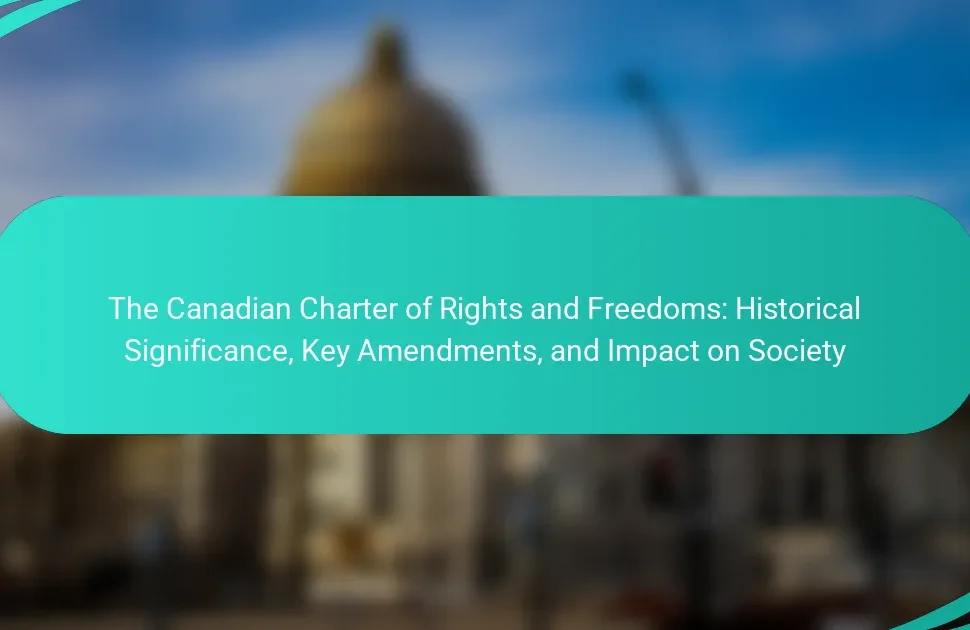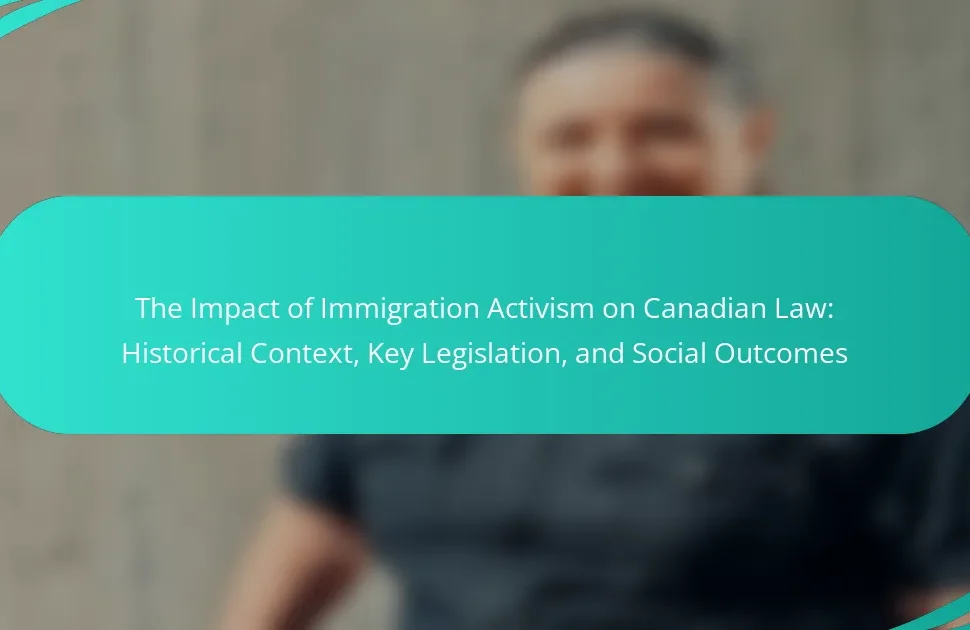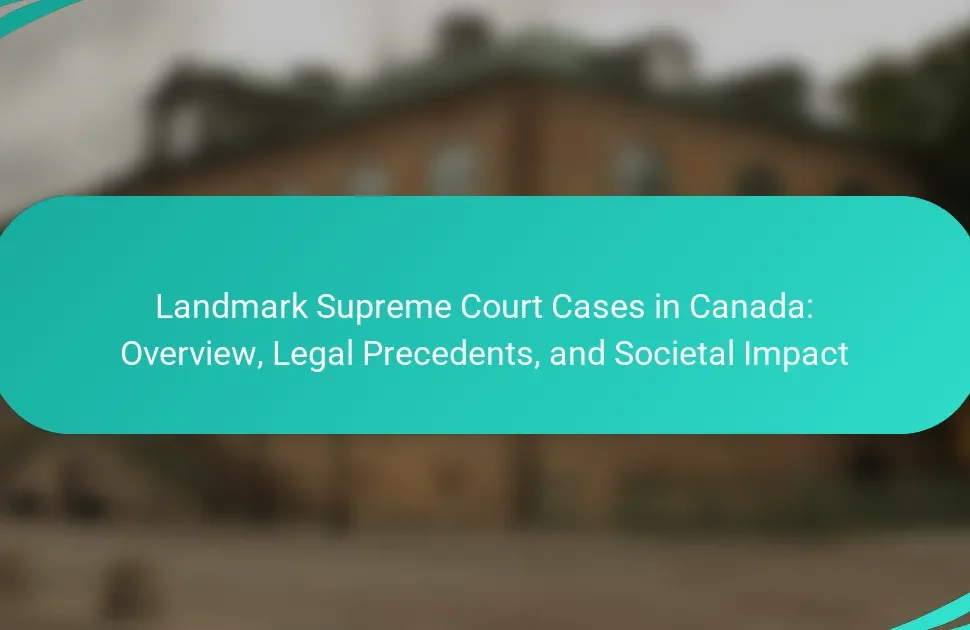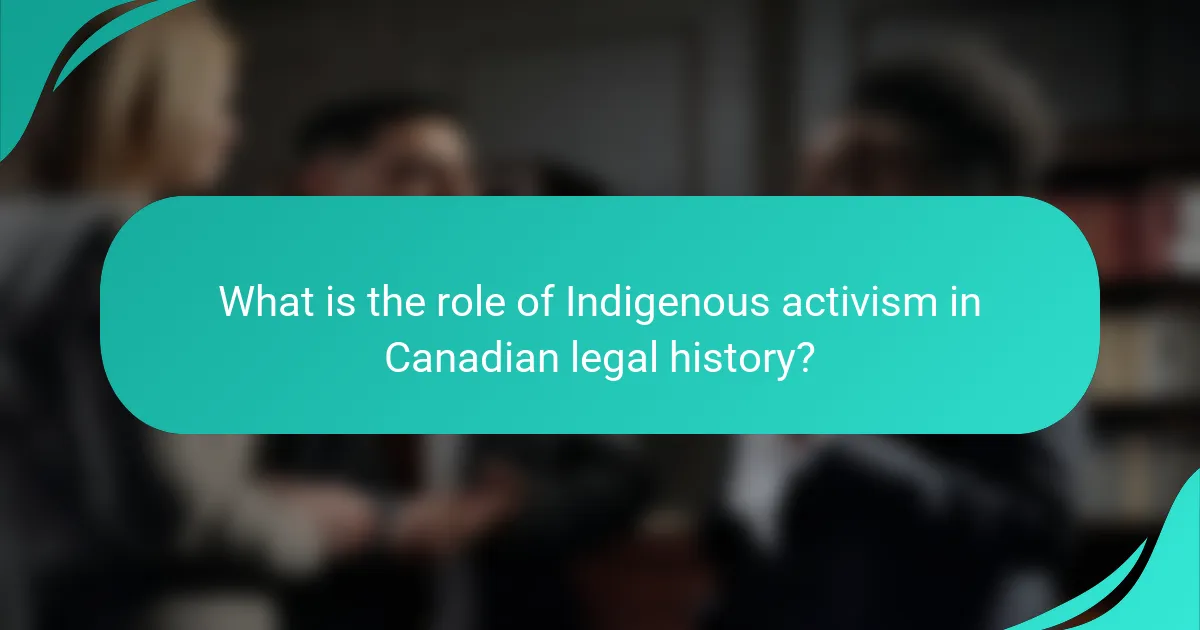
What is the role of Indigenous activism in Canadian legal history?
Indigenous activism has played a crucial role in shaping Canadian legal history. It has influenced landmark legal decisions and policies affecting Indigenous rights. Activists have fought for land rights, self-governance, and recognition of treaties. Key events include the Calder case in 1973, which acknowledged Aboriginal title. The 1990 Oka Crisis highlighted the need for dialogue on land disputes. Activism has also led to significant legislative changes, such as the Indian Act amendments. Indigenous leaders have consistently advocated for legal reforms to protect their rights. This activism has resulted in greater visibility and acknowledgment of Indigenous issues in Canadian law.
How has Indigenous activism influenced legal frameworks in Canada?
Indigenous activism has significantly influenced legal frameworks in Canada by advocating for the recognition of Indigenous rights. This activism has led to landmark legal decisions, such as the Calder case in 1973, which recognized Indigenous land rights. The Supreme Court’s decision in Delgamuukw in 1997 further affirmed the importance of oral histories in land claims. Additionally, the Royal Commission on Aboriginal Peoples in 1996 recommended constitutional changes to recognize Indigenous sovereignty. The 2014 Tsilhqot’in decision was a pivotal moment, as it granted title to Indigenous land for the first time. These legal advancements demonstrate the impact of sustained activism on Canadian law. Indigenous groups continue to push for reforms, influencing policies related to resource management and self-governance.
What historical context shaped Indigenous activism in Canada?
Indigenous activism in Canada was shaped by a history of colonialism and systemic oppression. The imposition of treaties often disregarded Indigenous rights and sovereignty. The Indian Act of 1876 institutionalized discrimination against Indigenous peoples. Residential schools aimed to assimilate Indigenous children, leading to cultural loss and trauma. The 1969 White Paper proposed eliminating Indigenous rights, sparking widespread opposition. The Oka Crisis in 1990 highlighted land rights issues and mobilized public support for Indigenous causes. The establishment of organizations like the Assembly of First Nations in 1982 provided a unified voice for Indigenous peoples. These historical events fostered resilience and advocacy for rights, self-determination, and recognition.
What are the foundational legal principles related to Indigenous rights?
The foundational legal principles related to Indigenous rights include the recognition of inherent rights, self-determination, and land rights. Inherent rights affirm that Indigenous peoples possess rights that predate colonial laws. Self-determination allows Indigenous groups to govern themselves and make decisions regarding their communities. Land rights recognize the connection between Indigenous peoples and their traditional territories. These principles are established in legal documents such as the Constitution Act of 1982, which includes Section 35, recognizing existing Indigenous rights. Additionally, the United Nations Declaration on the Rights of Indigenous Peoples supports these principles globally. Legal cases, such as Calder v. British Columbia, have further solidified these rights in Canadian law.
What major events have marked Indigenous activism in Canada?
Major events that have marked Indigenous activism in Canada include the 1969 White Paper, the Oka Crisis in 1990, and the Idle No More movement starting in 2012. The 1969 White Paper aimed to eliminate the Indian Act, which sparked widespread opposition from Indigenous leaders. The Oka Crisis involved a land dispute over a golf course expansion, leading to a standoff between Mohawk protestors and police. The Idle No More movement focused on environmental issues and Indigenous rights, mobilizing thousands across the country. These events highlight the ongoing struggle for rights and recognition among Indigenous peoples in Canada.
Which key protests and movements have had significant legal impacts?
Key protests and movements that have had significant legal impacts include the Oka Crisis, the Delgamuukw case, and the Idle No More movement. The Oka Crisis in 1990 involved a land dispute between Mohawk people and the Canadian government. This standoff led to increased awareness and legal recognition of Indigenous land rights. The Delgamuukw case in 1997 affirmed Indigenous land claims in British Columbia. It established that oral histories are valid evidence in land claims. The Idle No More movement, which began in 2012, focused on Indigenous rights and environmental issues. It spurred legislative discussions on Indigenous sovereignty and environmental protection. Each of these movements significantly influenced Canadian law and policy regarding Indigenous rights and land.
How did landmark court cases shape the landscape of Indigenous rights?
Landmark court cases significantly shaped Indigenous rights by establishing legal precedents. These cases affirmed the recognition of Indigenous land claims. For example, the 1973 Calder case recognized Indigenous title to land in British Columbia. The 1982 Constitution Act included Section 35, which acknowledged existing Indigenous rights. The 1990s Delgamuukw decision further clarified land rights and governance. Landmark rulings have empowered Indigenous communities to assert their rights legally. They have also influenced legislation and government policies regarding Indigenous affairs. Overall, these court cases have transformed the legal landscape for Indigenous rights in Canada.
Who are the key figures in Indigenous activism and their contributions?
Key figures in Indigenous activism include figures like Harold Cardinal, who advocated for Indigenous rights in Canada. He authored “The Unjust Society,” which highlighted systemic injustices faced by Indigenous peoples. Another significant figure is Elijah Harper, known for his role in blocking the Meech Lake Accord, emphasizing the need for Indigenous inclusion in constitutional discussions.
Additionally, Ovide Mercredi served as National Chief of the Assembly of First Nations and pushed for land claims and treaty rights. His leadership was pivotal in raising awareness about Indigenous issues.
Furthermore, Indigenous activist and author Leanne Betasamosake Simpson has contributed through her writings and public speaking, focusing on decolonization and Indigenous resurgence.
These individuals have significantly influenced legal and social changes, advocating for recognition and rights of Indigenous peoples in Canada.
What roles did Indigenous leaders play in advocating for legal changes?
Indigenous leaders played crucial roles in advocating for legal changes in Canada. They organized protests and campaigns to raise awareness about Indigenous rights. Leaders like Chief Dan George and Elijah Harper were instrumental in these efforts. They brought attention to issues such as land rights and self-governance. Indigenous leaders also participated in negotiations with the government. Their advocacy led to significant legal outcomes, including the recognition of treaty rights. The Constitution Act of 1982 included provisions for Indigenous rights, influenced by their activism. These actions have shaped the legal landscape for Indigenous peoples in Canada.
How have grassroots movements contributed to the legal recognition of Indigenous rights?
Grassroots movements have significantly contributed to the legal recognition of Indigenous rights through advocacy and activism. These movements have mobilized communities to demand recognition and protection of their rights. They have organized protests, campaigns, and legal challenges to raise awareness of Indigenous issues. Landmark events, such as the 1990 Oka Crisis, highlighted the urgency of Indigenous land rights. Activists have also worked to influence public opinion and policy changes. Their efforts have led to important legal precedents, such as the 2014 Tsilhqot’in Nation v. British Columbia case, which affirmed Indigenous land title. Grassroots movements have also played a crucial role in the development of the United Nations Declaration on the Rights of Indigenous Peoples. This collective action has pressured governments to amend legislation and recognize Indigenous rights formally. Overall, grassroots movements have been instrumental in advancing legal recognition and fostering dialogue on Indigenous issues.
How has legislation changed in response to Indigenous activism?
Legislation has changed significantly in response to Indigenous activism. Activism has led to the recognition of Indigenous rights in Canadian law. The Constitution Act of 1982 included Section 35, which recognizes and affirms the rights of Indigenous peoples. This was a direct result of years of advocacy and protests by Indigenous groups. The landmark Supreme Court case, Calder v. British Columbia (1973), acknowledged Indigenous land rights. This ruling was influenced by Indigenous activism and set a precedent for future cases. Additionally, the implementation of the Truth and Reconciliation Commission’s Calls to Action has prompted legislative reforms. These reforms aim to address historical injustices and improve relations with Indigenous communities. Overall, Indigenous activism has been pivotal in shaping Canadian legislation to better reflect Indigenous rights and sovereignty.
What are the most significant legislative changes influenced by Indigenous activism?
The most significant legislative changes influenced by Indigenous activism include the Indian Act amendments and the establishment of land claims agreements. The Indian Act, originally passed in 1876, underwent significant amendments in 1951 due to pressure from Indigenous groups. These amendments allowed for greater self-governance and the removal of discriminatory provisions.
Additionally, the 1982 Constitution Act recognized Indigenous rights, leading to increased legal protections for Indigenous peoples. The creation of modern land claims agreements, such as the 1993 Nisga’a Treaty, was influenced by Indigenous activism. These agreements provided formal recognition of land rights and self-governance.
Furthermore, the Truth and Reconciliation Commission’s recommendations have prompted legislative changes aimed at addressing historical injustices. These changes reflect the ongoing influence of Indigenous activism in shaping Canadian law and policy.
How do recent laws reflect the evolving relationship between Indigenous peoples and the Canadian government?
Recent laws demonstrate a shift towards recognizing Indigenous rights and sovereignty in Canada. Legislation such as the Indigenous Languages Act aims to preserve and promote Indigenous languages. The Act acknowledges the importance of language in cultural identity. Additionally, the introduction of the United Nations Declaration on the Rights of Indigenous Peoples Act reflects a commitment to align Canadian laws with international standards. This Act mandates consultation with Indigenous communities on legislation affecting them. Furthermore, the recognition of land rights through various settlement agreements indicates a move towards reconciliation. These changes illustrate a growing acknowledgment of Indigenous voices in governance. Overall, recent laws signify an evolving partnership between Indigenous peoples and the Canadian government.
What challenges does Indigenous activism face in the legal landscape?
Indigenous activism faces significant challenges in the legal landscape, primarily due to systemic barriers. These barriers include limited recognition of Indigenous rights within Canadian law. The legal system often prioritizes colonial frameworks over Indigenous sovereignty. Furthermore, legal processes can be lengthy and costly, which hinders grassroots movements. There is also a lack of adequate legal representation for Indigenous groups in court. Discriminatory practices and biases within the judiciary can further complicate legal battles. Additionally, the ongoing impacts of historical injustices affect the ability of Indigenous activists to navigate legal challenges effectively. These factors collectively undermine the effectiveness of Indigenous activism in achieving legal reforms and recognition.
How do systemic barriers impact Indigenous legal advocacy?
Systemic barriers significantly hinder Indigenous legal advocacy. These barriers include inadequate access to legal resources and representation. Indigenous communities often face financial constraints that limit their ability to engage legal services. Additionally, cultural misunderstandings between Indigenous peoples and legal institutions create further obstacles. Historical injustices and ongoing discrimination affect the trust Indigenous communities have in the legal system. According to a 2018 report by the Truth and Reconciliation Commission, systemic racism remains prevalent in Canadian legal processes. This context illustrates how systemic barriers impede effective advocacy for Indigenous rights and interests.
What strategies are being employed to overcome these challenges?
Indigenous activists employ a variety of strategies to overcome challenges in Canadian legal history. These strategies include legal advocacy, public awareness campaigns, and coalition building. Legal advocacy involves challenging unjust laws in courts, which has led to landmark rulings like the Calder case in 1973. Public awareness campaigns aim to educate the broader population about Indigenous rights and issues. Coalition building with non-Indigenous allies strengthens their efforts and increases visibility. Additionally, grassroots organizing mobilizes community members to participate in protests and support initiatives. These strategies collectively aim to address systemic injustices and promote Indigenous sovereignty.
What can be learned from the history of Indigenous activism in Canada?
The history of Indigenous activism in Canada reveals the resilience and determination of Indigenous peoples to assert their rights. It demonstrates the ongoing struggle for land, cultural preservation, and self-determination. Indigenous activism has led to significant legal changes, such as the recognition of treaty rights. Landmark events, like the Oka Crisis in 1990, highlighted the urgency of Indigenous issues. Key figures, such as Elijah Harper, played pivotal roles in advocating for Indigenous rights. The activism has also fostered greater awareness of Indigenous histories and injustices among the broader Canadian public. Overall, it underscores the importance of continued advocacy for equity and justice in Canada.
How can current activists apply lessons from past movements?
Current activists can apply lessons from past movements by studying effective strategies and tactics used historically. For example, the civil rights movement emphasized grassroots organizing and coalition-building. Activists can also learn from the successes of Indigenous movements in Canada, such as the Oka Crisis, which highlighted the importance of media engagement. Historical movements often utilized non-violent protest, which remains a powerful tool today. Additionally, past activists demonstrated the value of legal challenges to advance their causes. They also showed the necessity of persistence and adaptability in the face of opposition. By analyzing these approaches, current activists can enhance their effectiveness and impact.
What best practices can enhance the effectiveness of Indigenous legal advocacy?
Effective Indigenous legal advocacy can be enhanced through community engagement, cultural competency, and collaboration with legal experts. Community engagement ensures that the voices of Indigenous peoples are central to advocacy efforts. Cultural competency allows advocates to understand and respect Indigenous traditions and legal systems. Collaboration with legal experts can provide necessary resources and knowledge. Training programs for advocates can improve skills and awareness of Indigenous rights. Utilizing technology can broaden outreach and awareness. Documenting successes and challenges can inform future strategies. Engaging with allies strengthens support and amplifies advocacy efforts. These practices contribute to a more effective and inclusive approach to Indigenous legal advocacy.
The main entity of this article is Indigenous activism in Canada and its impact on legal history. The article explores how Indigenous activism has shaped legal frameworks, highlighted key events such as the Calder case and the Oka Crisis, and identified influential figures like Elijah Harper. It examines foundational legal principles related to Indigenous rights and discusses significant legislative changes resulting from activism, including amendments to the Indian Act and the recognition of land rights. Additionally, the article addresses the challenges faced by Indigenous activists and outlines strategies for overcoming these obstacles to advance legal recognition and advocacy for Indigenous rights.
